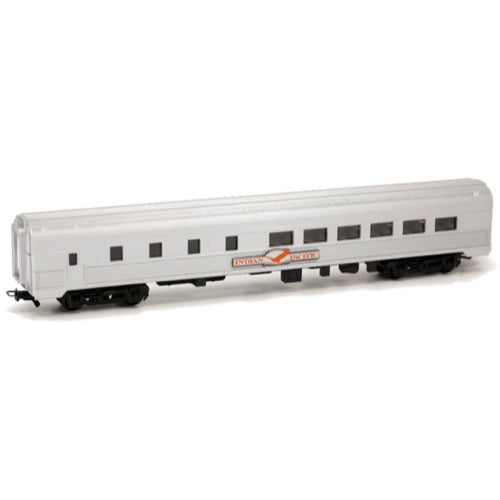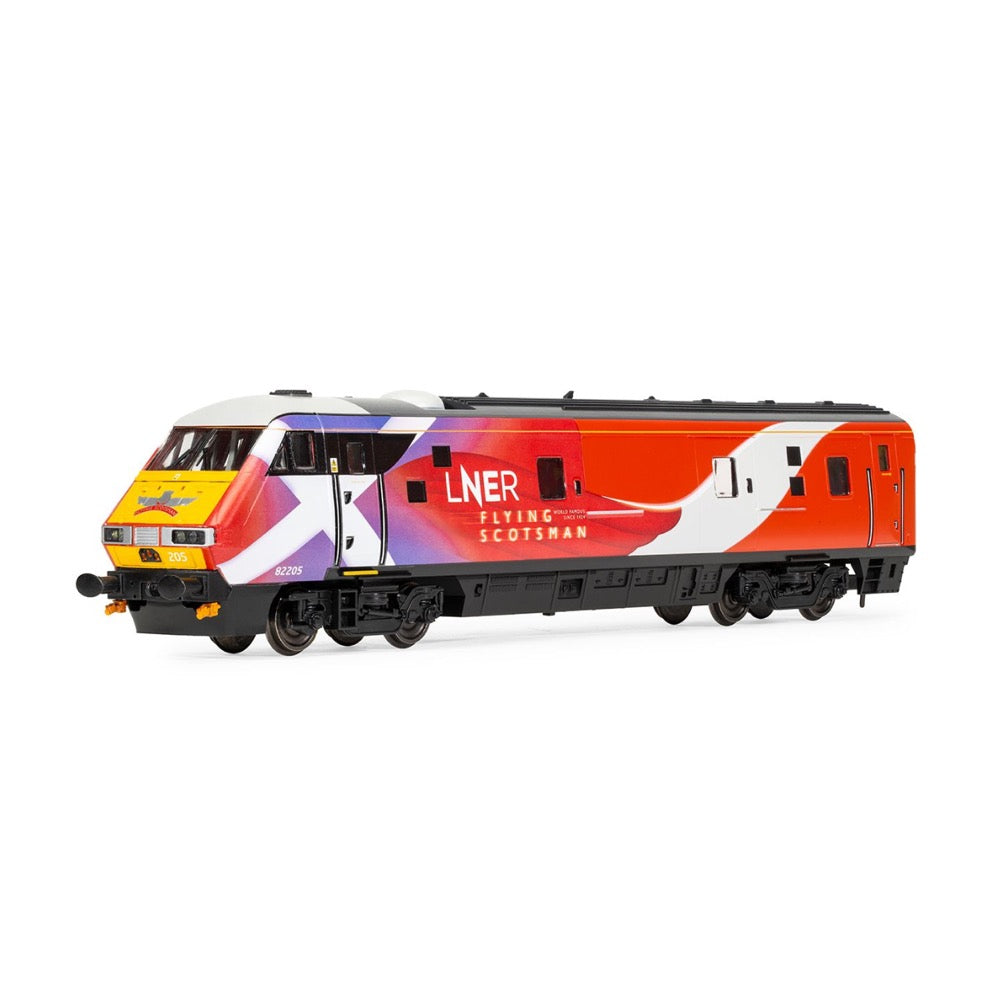
Hornby R40370 OO LNER Flying Scotsman Mk4 DVT 82205
The East Coast Main Line over which the 'Flying Scotsman' runs was built in the 19th century by many small railway companies, but mergers and acquisitions led to only three companies controlling the route; the North British Railway (NBR), the North Eastern Railway (NER) and the Great Northern Railway (GNR). In 1860 the three companies established the East Coast Joint Stock for through services using common vehicles, and it is from this agreement that the 'Flying Scotsman' came about.
The 'Flying Scotsman' name has been maintained by the operators of the InterCity East Coast franchise since privatisation of British Rail; the former Great North Eastern Railway even subtitled itself The Route of the Flying Scotsman. The Flying Scotsman was operated by GNER from April 1996 until November 2007, then by National Express East Coast until November 2009, East Coast until April 2015, and Virgin Trains East Coast until June 2018. Since then, it has been operated by the government-owned London North Eastern Railway.
On 23 May 2011 the Flying Scotsman brand was relaunched for a special daily fast service operated by East Coast departing Edinburgh at 05:40 and reaching London in exactly four hours, calling only at Newcastle, operated by an InterCity 225 'Mallard' set. 91 class locomotive 91101 and Driving Van Trailer 82205 were turned out in a special maroon livery for the launch of the service. East Coast said bringing back named trains would restore "a touch of glamour and romance". However, for the first time in its history, it ran in one direction only: there is no northbound equivalent service. This schedule is maintained today. Northbound, the fastest timetabled London to Edinburgh service now takes 4 hours 19 minutes. In October 2015, 91101 and 82205 were revinyled in a new Flying Scotsman livery.
The Flying Scotsman is the only passenger service to run non-stop through Darlington and York. LNER's new "Azuma" units (Class 800s and Class 801s) took over the service on 1 August 2019. Since then, this one train is scheduled to run to London in 4 hours exactly.
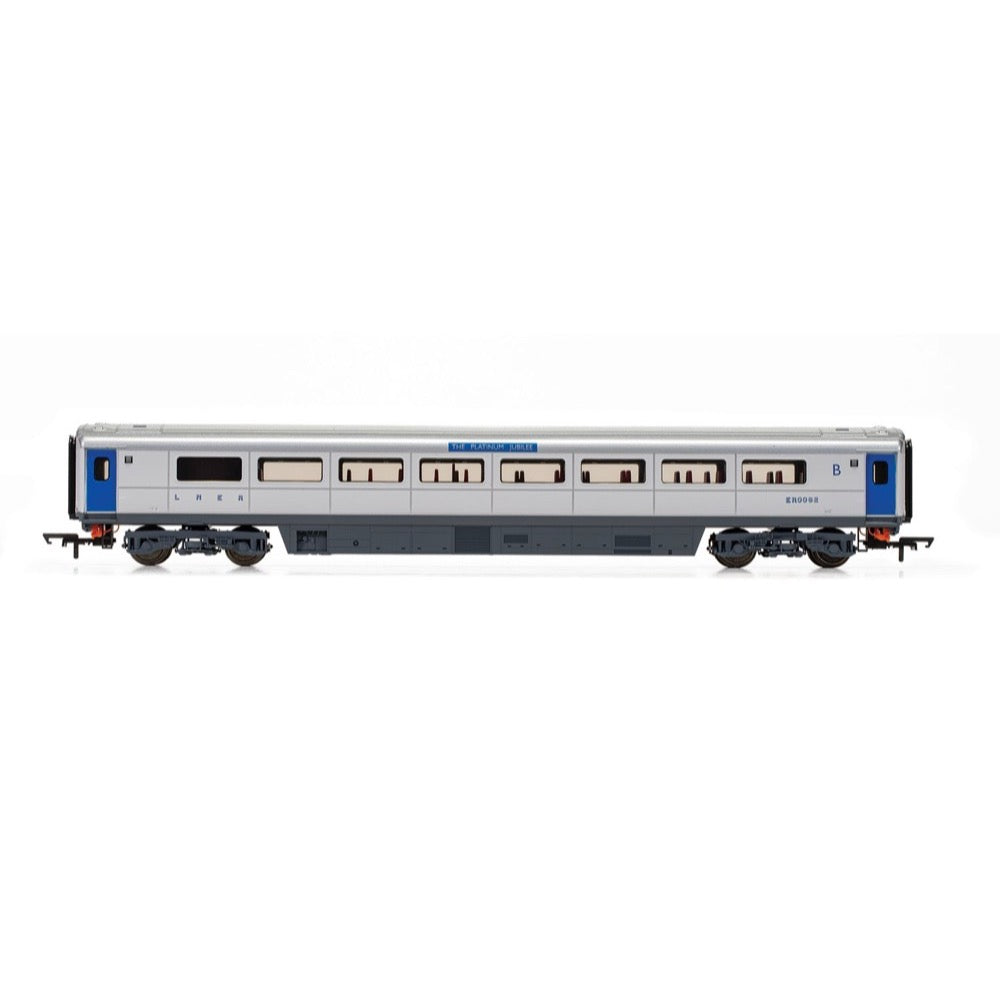
Hornby R40355 OO Platinum Jubilee of HM Queen Elizabeth II Mk3 Sliding Door Trailer First Disabled ER0062
Running with the Platinum Jubilee HST units, this coach reimagines what the ageing Mk3 coaches may have looked like in this celebratory Platinum Jubilee year under the old LNER. Full trains of these could have been used to commemorate such an occasion had nationalisation simply not happened. In a Platinum Jubilee silver with blue trim livery with re-purposed destination boards, the six First Class and two First Class Restaurant sliding door Mk3 coaches would indeed make a never to be forgotten image while being pulled along the East Coast Main Line at high speed. The sleek lines combined with more than a salute to the art deco style of the 1937 ‘Coronation’ train, plus the wonderful opulence and style such a service offered, brings fanciful imaginings into reality, if only in model form. This coach is numbered ER0062, in celebration of the Queen’s 10th year on the throne.
Specification
- Item Length - Without Packaging (cm): 30.3
- Item Height - Without Packaging (cm): 5
- Item Width - Without Packaging (cm): 3.5
- Item Weight - Without Packaging: 0.19
- Item Scale: 1:76 Scale 00 Gauge
- Finish: Painted
- Colour: Silver
- Operator: LNER
- Designer: Wabtec Doncaster
- Livery: HM Platinum Jubilee
- Minimum Curve (mm): Radius 2
- Number of Parts: 1
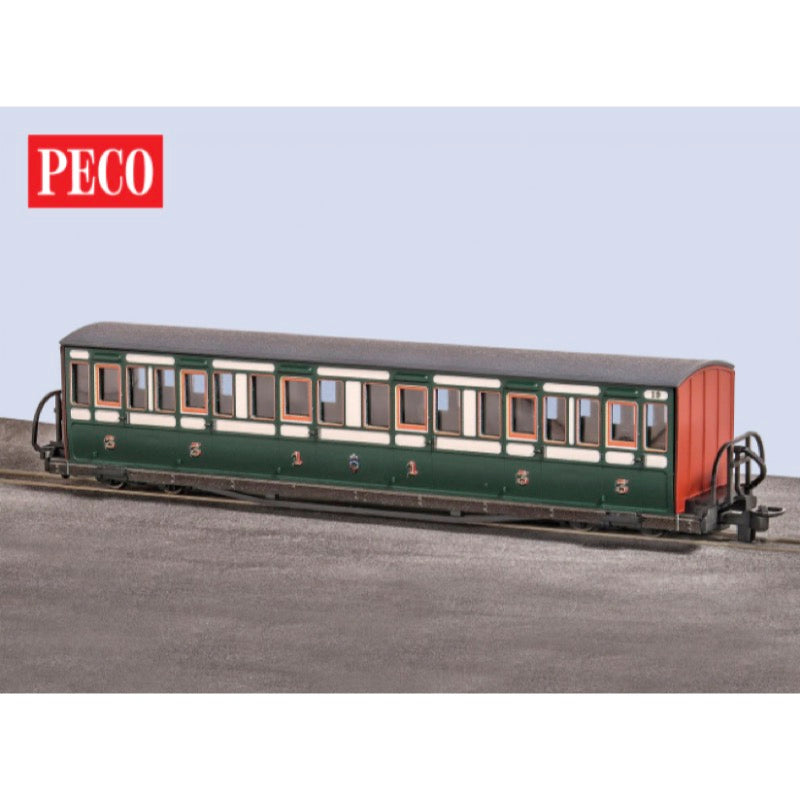
Peco GR621A GLT OO-9 FR Short Bowsider Bogie Coach Early Preservation Green 19
FR Short 'Bowsider' Bogie Coach - Early Preservation - Green 19
The four coaches in this group of vehicles were known as the 'Bowsiders' because of the shape of their sides, and were supplied by two builders in 1876 and 1879. Numbers 17 and 18 are the shorter coaches, delivered in 1876, and the two long coaches, numbers 19 and 20, arrived three years later in 1879. All four are in service on the Ffestiniog Railway today.
Our new models capture the subtle style of these coaches, with the 'bow' towards the bottom of the sides. The models feature very fine print detail too, including the Ffestiniog Railway company emblem. The livery is green with a cream trim around the upper half of the coach, and contrasting maroon end panels.
No. 17 wears this livery today. Fitted with metal-tyred wheels the coaches are lovely smooth runners.
PECO 009 Irregular and Mainline Code 80 Setrack and Streamline track systems
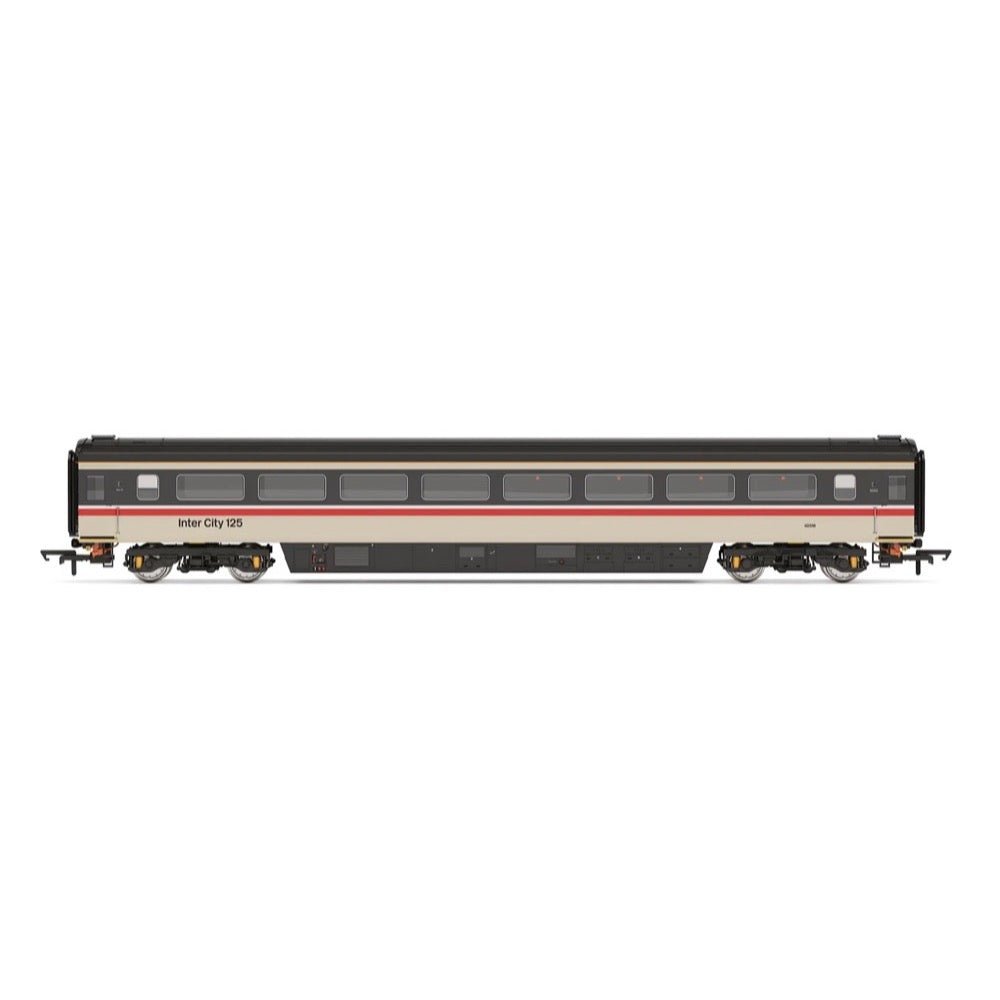
Hornby R40238 OO BR InterCity Mk3 Tourist Standard Open 42336 Era 8
In-order to allow running at 125 mph on Britain's Victorian era railways, new rolling stock was needed by British Railways. Significant improvements over the Mk2 included new secondary air suspension between the bogies and the coach body as well as aerodynamic skirting on the underframe.
Mk3 coaches are 75ft (23m) long enabling far greater capacity than older coaches. Mk3 coaches also incorporate disk brakes and wheel slip protection enabling faster deceleration. The first Mk3 coaches to be delivered were used as part of the HST prototype along with the two Class 41 diesel power cars in 1972.
Mk3 coaches entered service in 1975 along with the Class 43 forming the iconic InterCity 125 trainset. After the HST Mk3 coach variant was introduced, further Mk3 coaches were introduced to the West Coast Mainline for use as part of locomotive hauled trains. Whilst Mk3 stock is standard for HST units, the standard locomotive hauled stock is Mk3a.
Mk3a stock differs from Mk3 stock due to the inclusion of buffers as well as a different electrical system that uses motor generator units in each coach to power air conditioning and other ancillaries Mk3a stock was built until 1984, before 3B stock with improved seating and lighting was built from 1985 to 1988.
After their brief stint in the BR Blue and Grey colour scheme the Mark 3 coaches saw a livery change in line with a corporate rebrand of high speed services. The new InterCity livery saw the coaches painted in a darker grey colour with a beige stripe along the top and bottom of the coaches with a red stripe under the windows. This livery was designed to emulate or copy the advanced yet ultimately fruitless APT project.
This livery would largely remain unchanged even after a further rebrand to Intercity Swallow, before the coaches would transfer into private ownership at the end of BR.These Mk3 coaches include the provision for lighting provided by the R7305 Maglight lighting unit, as well as fully detailed interiors and metal wheels throughout. For the first time, these coaches also include our new Buckeye style magnetic couplings.
Specification
- Item Length - Without Packaging (cm): 30.3
- Item Height - Without Packaging (cm): 5.5
- Item Width - Without Packaging (cm): 3.5
- Item Weight - Without Packaging: 0.158
- Item Scale: 1:76 Scale 00 Gauge
- Finish: Painted
- Colour: Grey
- Gauge: OO
- Operator: BR
- Designer: BREL
- Livery: BR Intercity Grey
- Minimum Curve (mm): Radius 2
- Number of Parts: 1
- Coupling Type: NEM Tension Lock
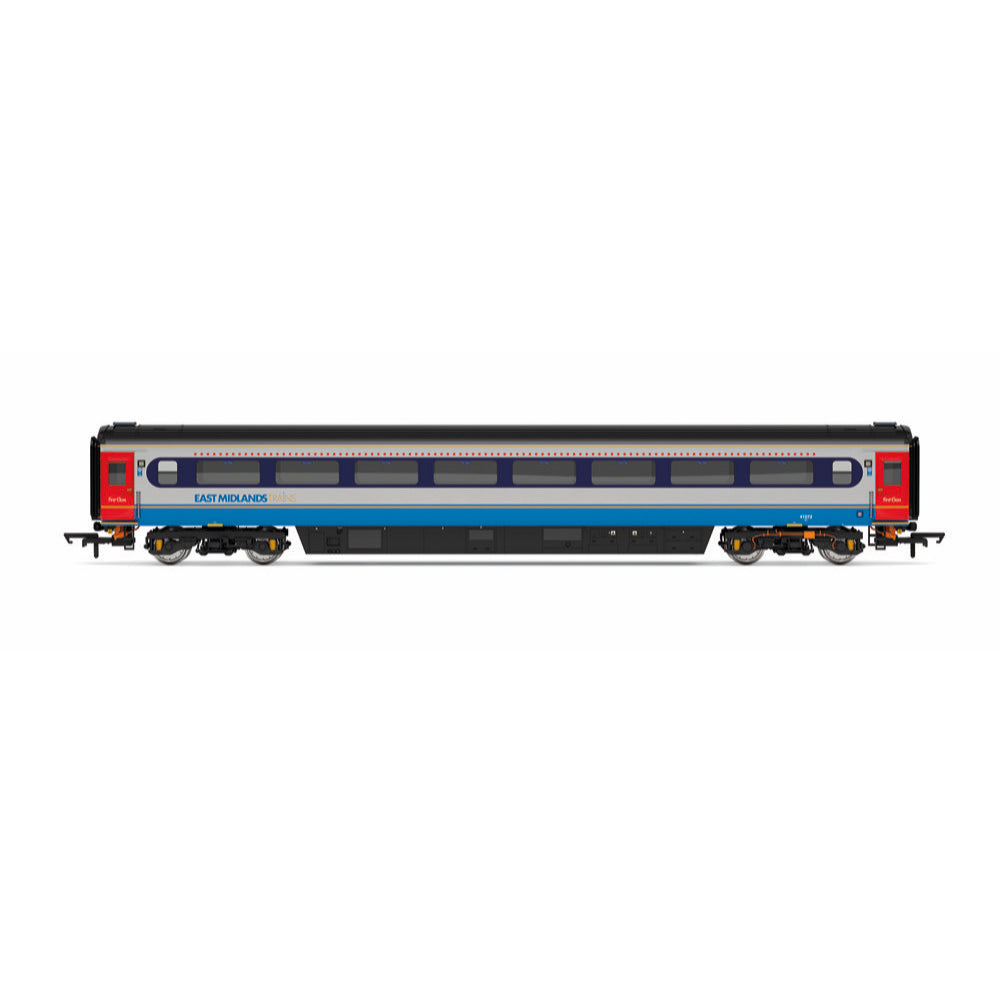
Hornby R40367 OO East Midlands MK3 Coach G 41072
In-order to allow running at 125 mph on Britain's railways, new rolling stock was needed by British Railways, and a new Mark entered service in 1975. Significant improvements over the Mk2 included new secondary air suspension between the bogies and the coach body as well as aerodynamic skirting on the underframe. Mk3 Coaches are 75ft (23m) long enabling far greater capacity than older coaches. Mk3 Coaches also incorporate disk breaks and wheel slip protection enabling faster deceleration.The first Mk3 Coaches to be delivered were used as part of the HST prototype along with the two Class 41 diesel power cars in 1972. Mk3 Coaches entered service in 1975 along with the Class 43 forming the iconic InterCity 125 trainset.After the HST Mk3 Coach variant was introduced, further Mk3 Coaches were introduced to the West Coast Mainline for use as part of locomotive hauled trains. Mk3s remain in service as part of HSTs with East Midlands Railway among other companies.
The British Rail Mk3 Coach was developed primarily for the Class 43 HST, but incorporated design features to enable it to be hauled by conventional locomotives. The first coach entered service in 1975 and the last were made in 1988. Most Mk3 Coaches built are still in service today, including a part of the Royal Train.
Specifications
- Item Length - Without Packaging (cm): 30.3
- Item Height - Without Packaging (cm): 5
- Item Width - Without Packaging (cm): 3.5
- Item Weight - Without Packaging: 0.19
- Item Scale: 1:76 Scale 00 Gauge
- Finish: Painted
- Colour: Blue
- Operator: East Midlands Railway
- Designer: Sir Kenneth Grange
- Livery: East Midlands Red/Blue
- Minimum Curve (mm): Radius 2
- Number of Parts: 1
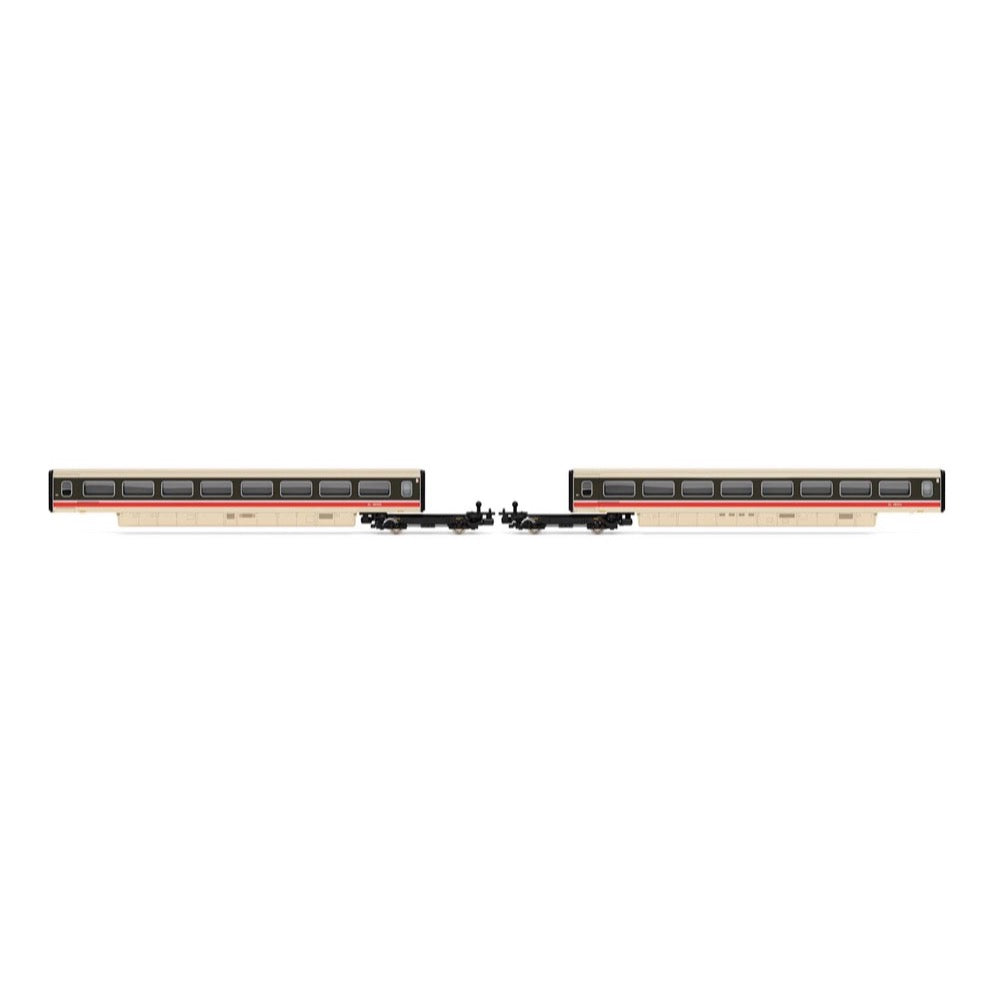
Hornby R40211A OO BR Class 370 Advanced Passenger Train 2-car TU Coach Pack 48303 and 48304
British Rail's Class 370 tilting trains, also referred to as APT-P (Advanced Passenger Train Prototype), were the pre-production Advanced Passenger Train units. The APT-P is the most powerful domestic train to have operated in Britain, setting the UK rail speed record of 162.2 miles per hour in 1979, a record that stood for 23 years. This TU 2-car Coach Pack features the Trailer Unclassified, as part of Sets 370003 and 370004.
Coach Running Numbers: 48303 & 48304
Includes
- 2x Rolling stock Coach
Technical Specifications
- Item Length - Without Packaging (cm): 27.6
- Item Height - Without Packaging (cm): 5
- Item Width - Without Packaging (cm): 3.5
- Item Weight - Without Packaging: 0.14
- Item Scale: 1:76 Scale 00 Gauge
- Finish: Painted
- Colour: Magnolia
- Operator: BR
- Designer: BREL
- Livery: Intercity Executive
- Minimum Curve (mm): Radius 2
- Motor: 5 Pole Skew wound
- Number of Parts: 2
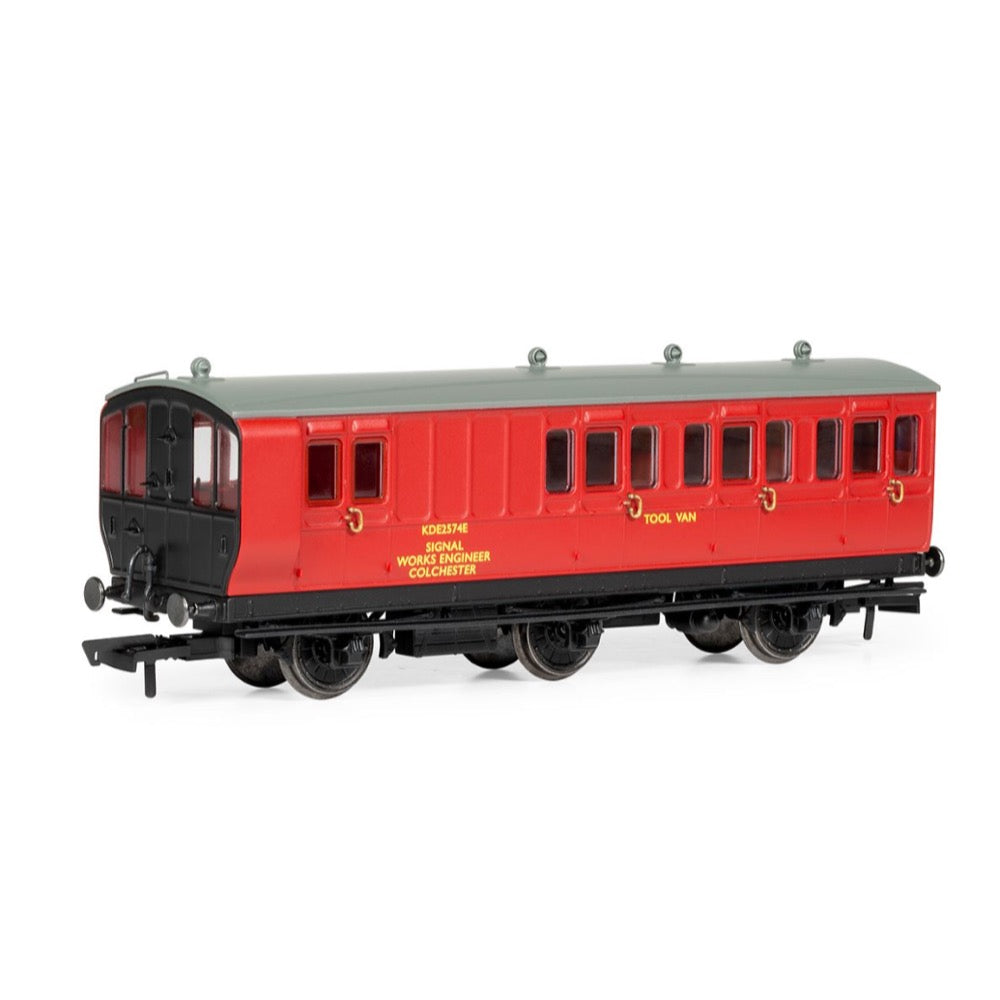
Hornby R40360 BR Departmental 6 Wheel Tool Van ERA 7
This 6 Wheeled Coach is a representation of the many small coaches which survived into British Railway ownership. Small coaches such as these proved especially adept at branch line work, where their small size enabled the traversing of tight radius curves, the ability to be hauled by smaller engines, and they were more acceptable to lower passenger numbers. The Tool Van served as a vital addition to many trains, carrying the important tools required for proper maintenance and repair.
Specification
- Item Length - Without Packaging (cm): 16
- Item Height - Without Packaging (cm): 5
- Item Width - Without Packaging (cm): 3.5
- Item Weight - Without Packaging: 0.07
- Item Scale: 1:76 Scale 00 Gauge
- Finish: Painted
- Colour: Red
- Operator: BR
- Designer: BR
- Livery: Departmental Red/Blue
- Minimum Curve (mm): Radius 2
- Number of Parts: 1
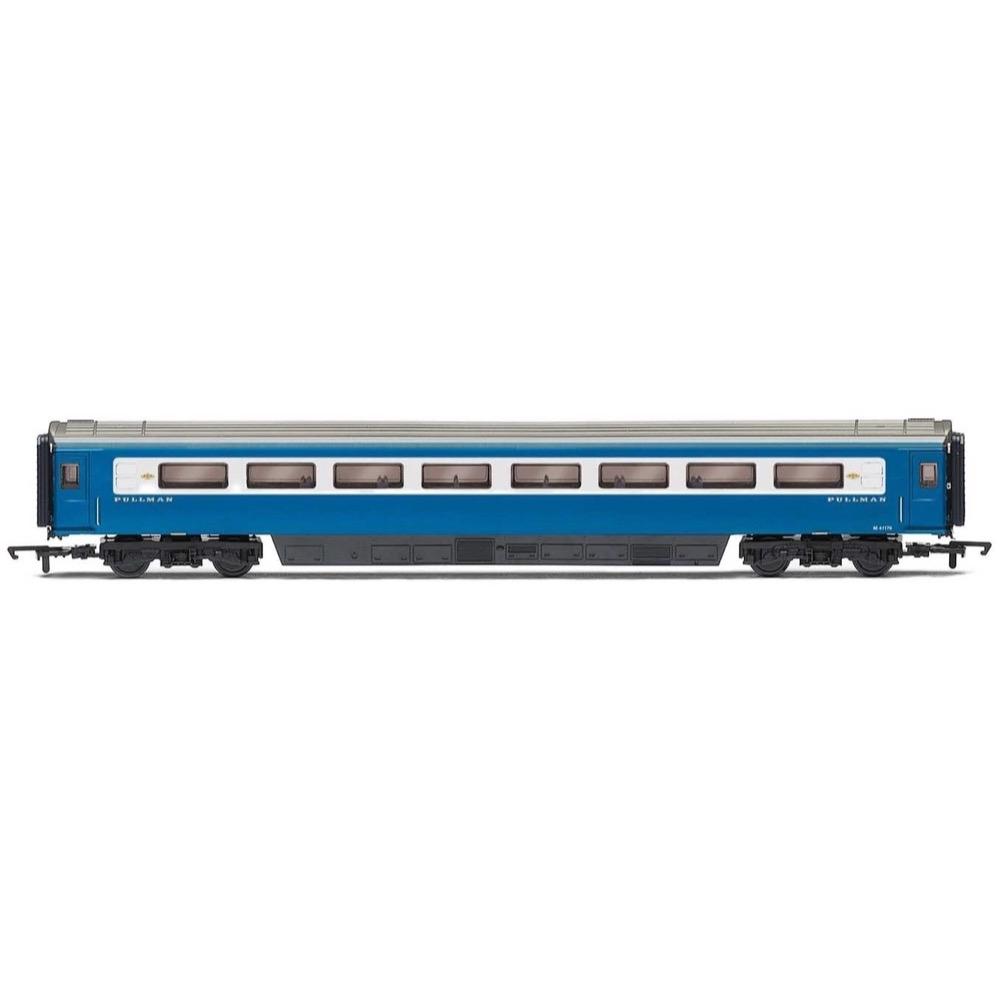
Hornby R40174 OO Midland Pullman Mk3 Trailer Buffet M40802
In-order to allow running at 125 mph on Britain's Victorian era railways, new rolling stock was needed by British Railways. Significant improvements over the Mk2 included new secondary air suspension between the bogies and the coach body as well as aerodynamic skirting on the underframe. Mk3 coaches are 75ft (23m) long enabling far greater capacity than older coaches. Mk3 coaches also incorporate disk brakes and wheel slip protection enabling faster deceleration. The first Mk3 coaches to be delivered were used as part of the HST prototype along with the two Class 41 diesel power cars in 1972.
Mk3 coaches entered service in 1975 along with the Class 43 forming the iconic InterCity 125 trainset. After the HST Mk3 coach variant was introduced, further Mk3 coaches were introduced to the West Coast Mainline for use as part of locomotive hauled trains. Whilst Mk3 stock is standard for HST units, the standard locomotive hauled stock is Mk3a. Mk3a stock differs from Mk3 stock due to the inclusion of buffers as well as a different electrical system that uses motor generator units in each coach to power air conditioning and other ancillaries Mk3a stock was built until 1984, before 3B stock with improved seating and lighting was built from 1985 to 1988.
Locomotive Services Limited (LSL) are a train operating company known for operating mainline rail tours with heritage diesel and steam locomotives. In 2017, upon being granted their certification to operate mainline charters, they became only the third company certified to operate steam locomotives on the mainline. They are also responsible for reimagining the famous Blue Pullman service, operating a specially liveried HST set with all first-class seating between London and Manchester.
The image shows the livery as it was in 2021.
Specifications
- Item Length - Without Packaging (cm): 30.3
- Item Height - Without Packaging (cm): 5
- Item Width - Without Packaging (cm): 3.5
- Item Weight - Without Packaging: 0.19
- Item Scale: 1:76 Scale 00 Gauge
- License: Yes
- License line: ©Copyright Locomotive Storage Limited 20… All rights reserved
- Finish: Painted
- Colour: Blue
- Gauge: OO
- Operator: Locomotive Services Group
- Designer: BREL
- Livery: Nanking Blue
- Minimum Curve (mm): Radius 2
- Number of Parts: 1
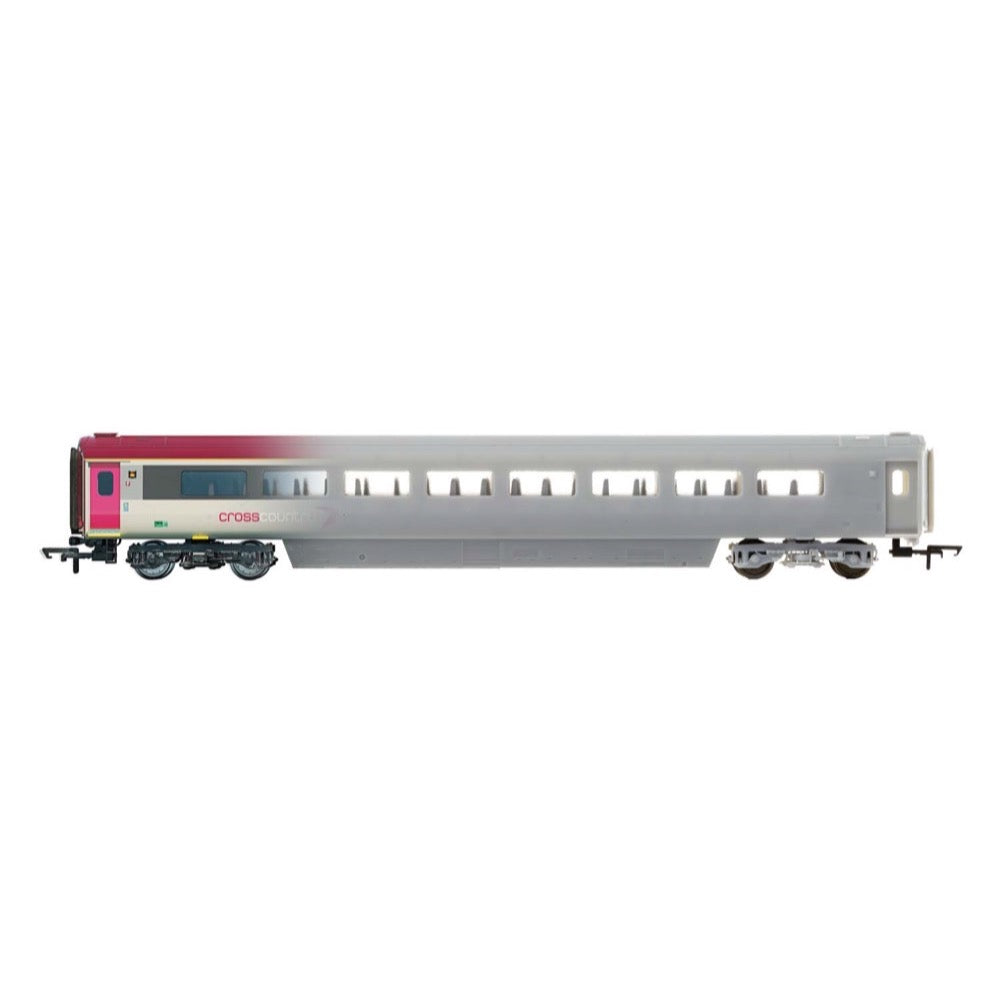
Hornby R4940C Cross Country Trains Mk3 Sliding Door TS - Era 11
Hornby R4940C Mk3 'Sliding door' TS trailer standard 42370 in Cross Country Trains livery - Coach 'C'
Specifications
- Length: 303mm
- Period: Era 11 (2014 +)
- Operator/Livery: Cross Country, Purple/Grey
- Designer: Wabtec Doncaster

Hornby R60260 Shell-Mex, TTA Tank Wagon Triple Pack 1982 - 1997
The TTA tanker is one of the most common types of tanker wagon ever seen on British railways. While far from the first or last such wagon to be used, the standardised nature and relative simplicity of the mechanisms in the tank and chassis led to thousands being built during the 1960s and 70s.
This triple TTA tank wagon pack consists of three Shell-Mex-liveried tank wagons with the running numbers: 501, 502 and 503.
Includes
- 3x Rolling Stock Wagons
Technical Specifications
- Item Length - Without Packaging (cm): 12
- Item Height - Without Packaging (cm): 5
- Item Width - Without Packaging (cm): 3.5
- Item Weight - Without Packaging: 0.05
- Item Scale: 1:76 Scale 00 Gauge
- Finish: Painted
- Colour: Grey
- Gauge: OO
- Operator: Shell-Mex
- Designer: BR
- Livery: Shell-Mex
- Minimum Curve (mm): Radius 2
- Number of Parts: 1
- Buffer Type: Metal Sprung Buffers
- Coupling Type: NEM Couplings
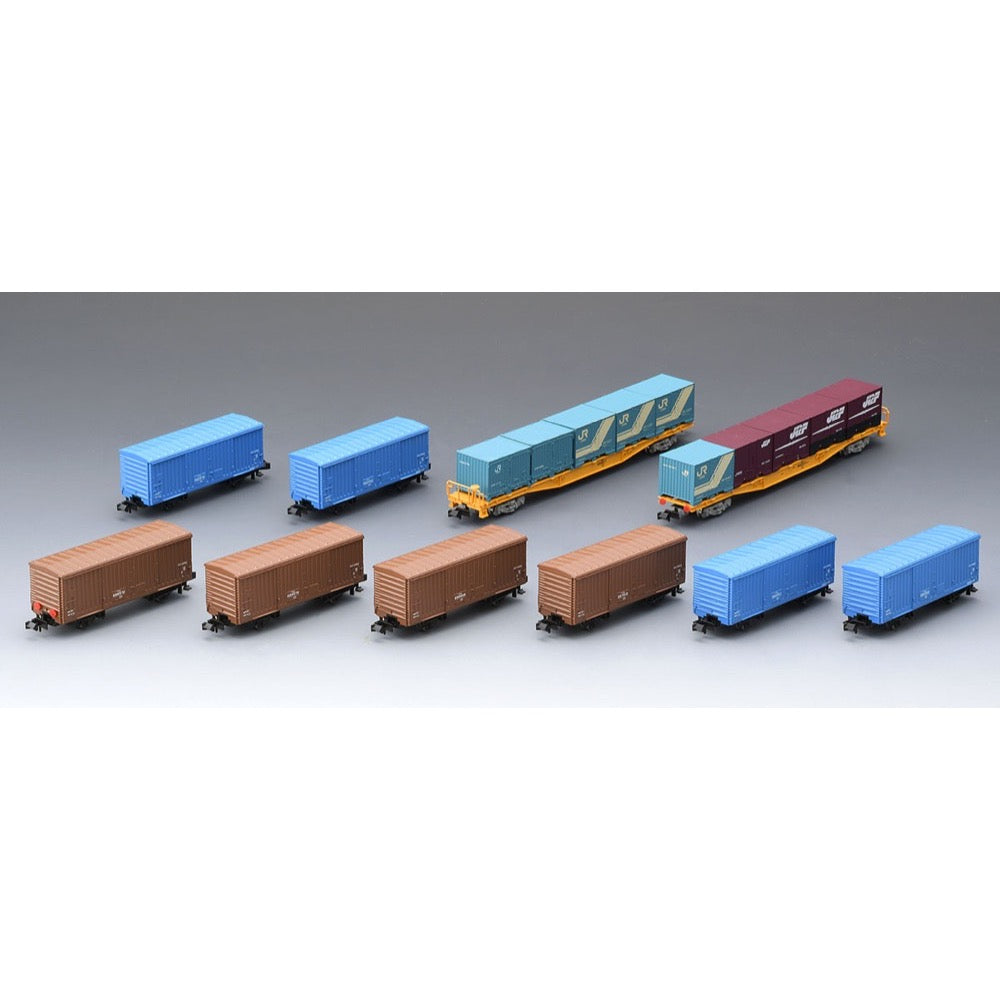
Tomix 98857 N 98857 Tokaido Line Paper Trans. Freight Train Set 10 Cars
The WAM80000 series continued to be used on paper transport freight trains even after the JR takeover, but was withdrawn from service in 2012.
Some paper transport freight trains running in the Tokyo metropolitan area were fitted with several container freight cars, and until around 2007 they were characterized by the large number of KoKi 350000 series cars.
Features
- A set based on the image of freight trains with WAM and KOKi cars coupled together, as seen on the Musashino Line and Tokaido Main Line
- WAM 280000, 380000, KOKi 350000 type freight cars and each container have their car numbers and markings printed on them - C36, 18D, 19A, and 19B type containers included (C36-1712, 5563, 18D-4410, 11383, 15078, 20397, 19A-978, 1001, 19B-2578, 1918R)
- C36-1712 reproduces the appearance with the JR mark attached
- 19B-2578 reproduces the large appearance of the JRF mark
- 19B-1918R reproduces the small appearance of the JRF mark
- Reflector, reflector installation jig for WAM80000 type included
- WAM80000 and 380000 types use black wheels
- Koki 350000 type uses gray bogie frame, silver wheels
Contents
Vehicles
- WAM 286570
- WAM 286579
- WAM 286688
- WAM 287819
- WAM 380001
- WAM 380303
- WAM 380379
- WAM 380444
- Koki 350017
- Koki 350037
Accessories
- Runner parts: reflector
- Parts: jig


